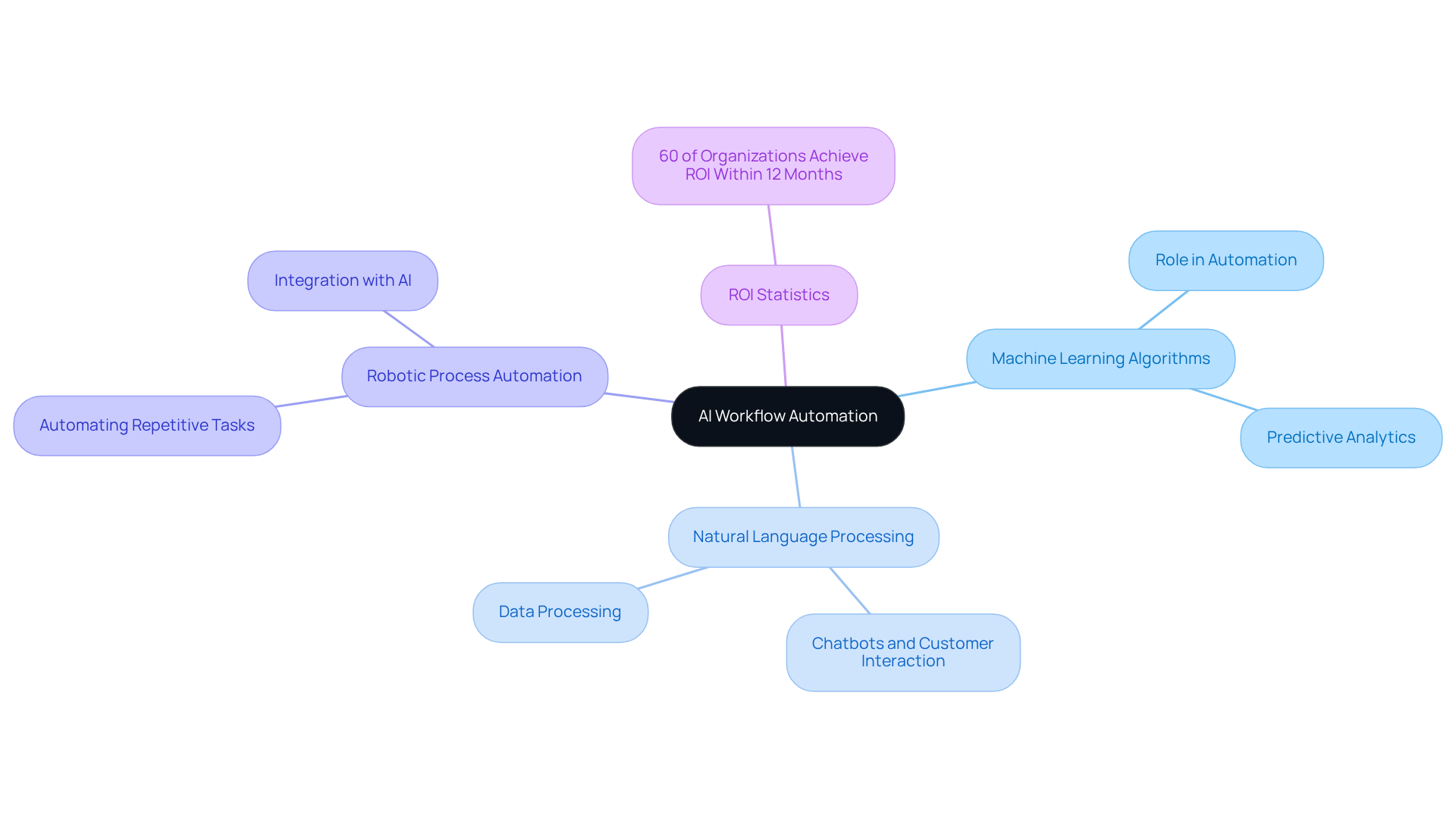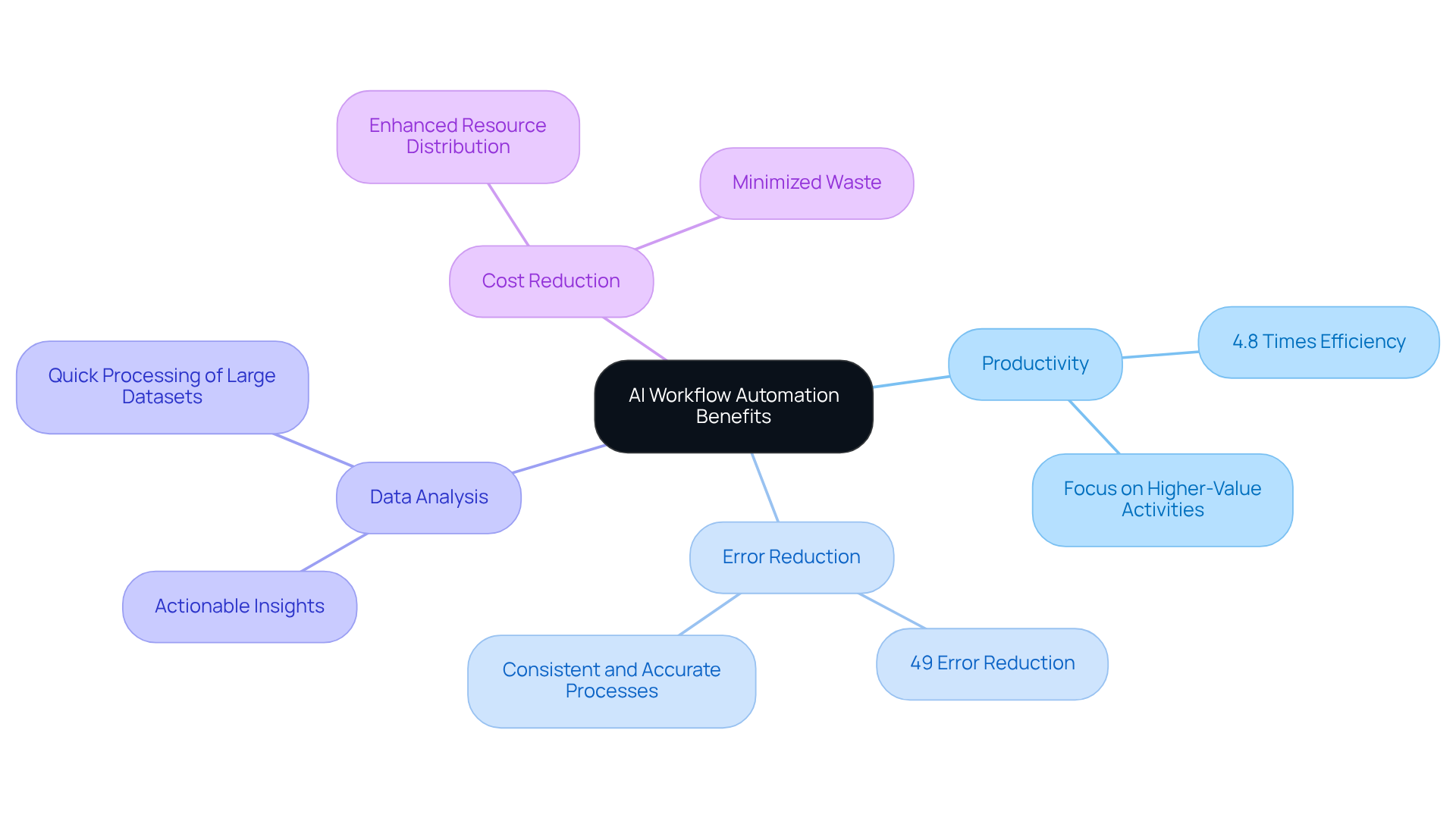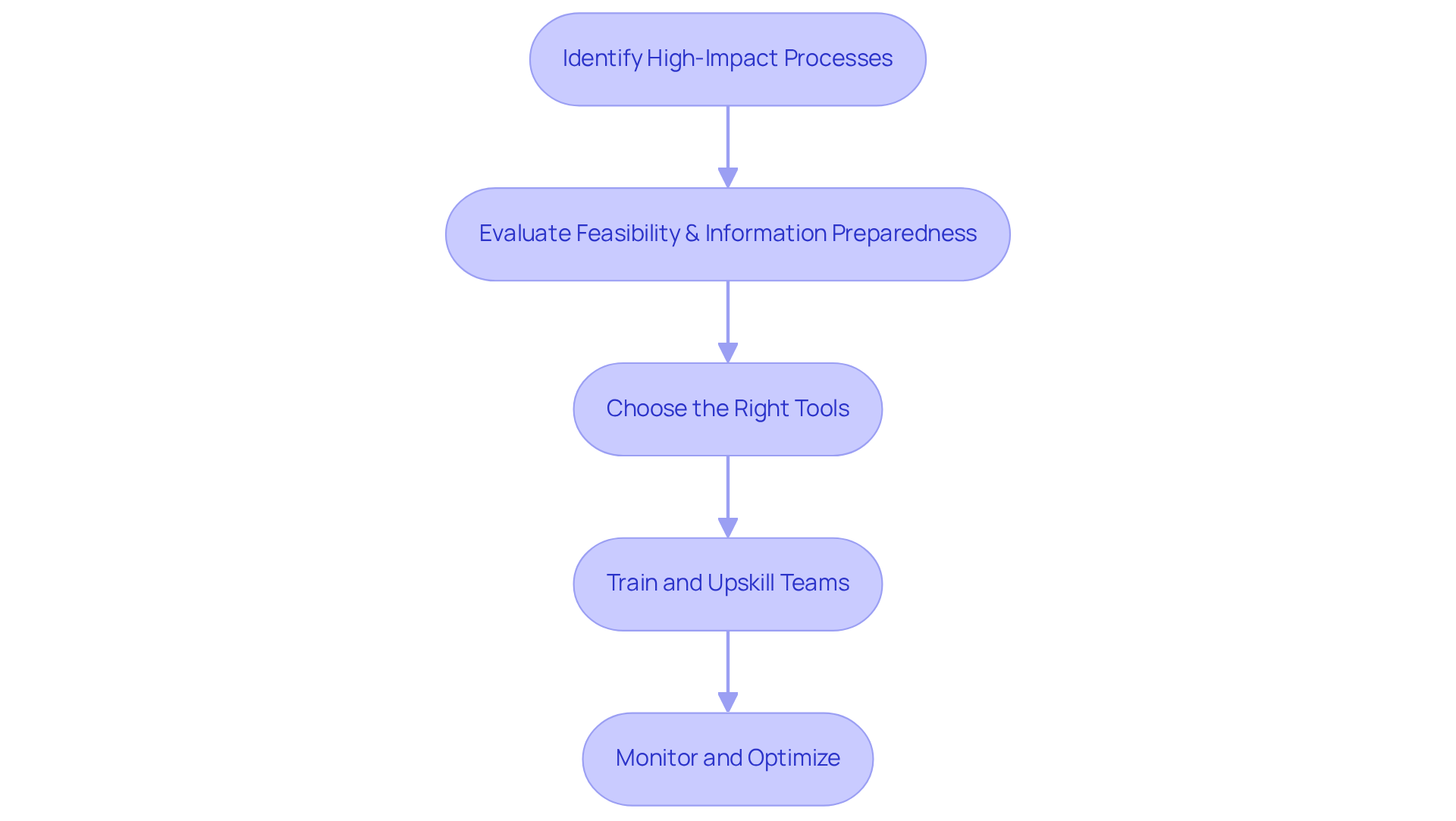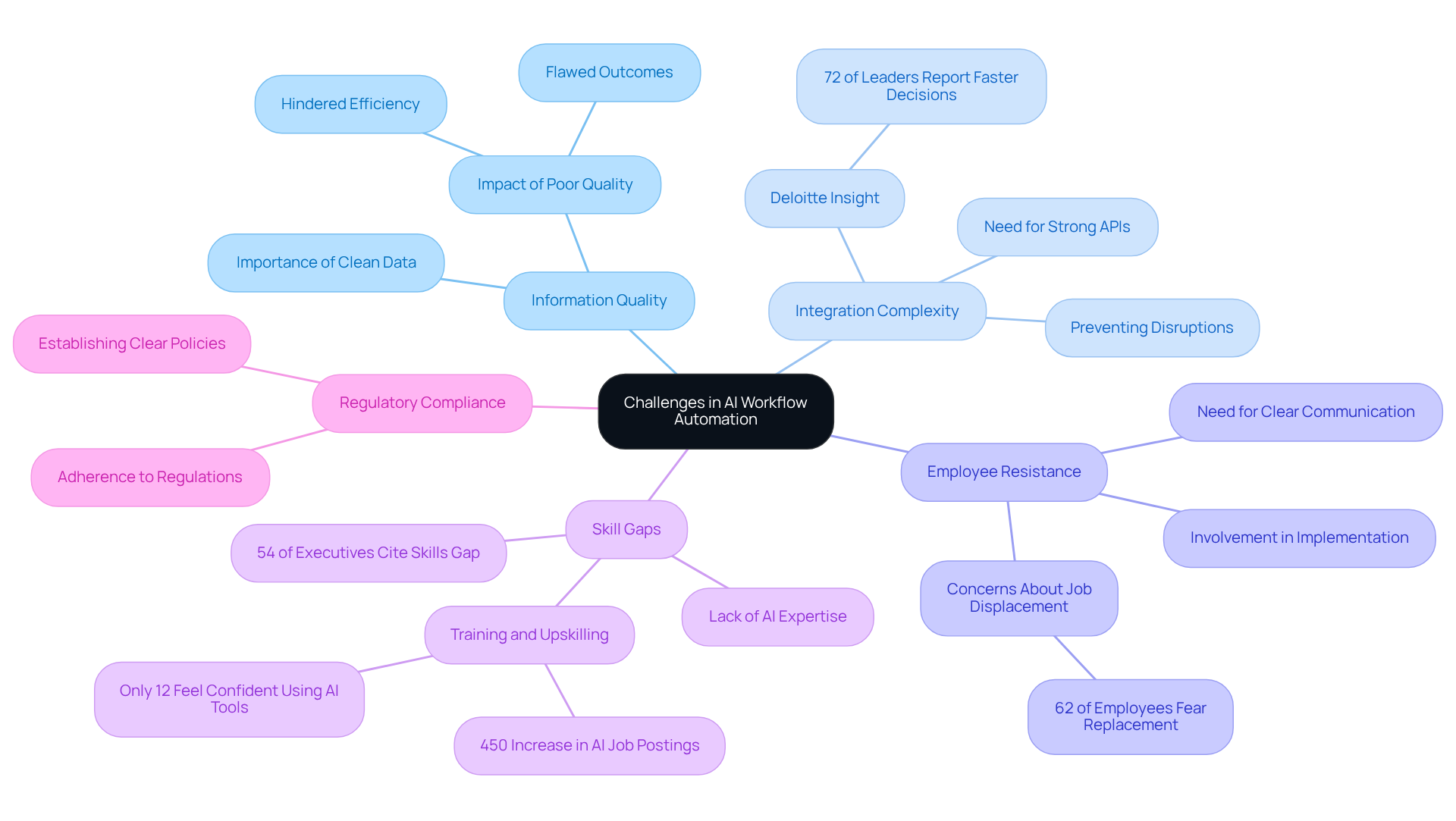Overview
The article emphasizes the significance of effective AI workflow automation, outlining four key strategies:
- Identifying high-impact processes
- Ensuring data readiness
- Selecting appropriate tools
- Providing necessary training to employees
These strategies are supported by evidence indicating that organizations can significantly enhance operational efficiency, reduce errors, and achieve a return on investment within a year. This highlights the transformative potential of AI in business processes, encouraging organizations to explore these strategies for improved outcomes.
Introduction
AI workflow automation is revolutionizing organizational operations, transforming mundane tasks into streamlined processes that enhance productivity and decision-making. By harnessing the power of artificial intelligence, businesses can significantly reduce manual effort, minimize errors, and empower their teams to focus on strategic initiatives.
However, as companies rush to adopt these innovative solutions, they often encounter challenges such as:
- Data quality
- Employee resistance
- Integration complexities
What strategies can organizations employ to ensure successful implementation and maximize the benefits of AI workflow automation? Furthermore, understanding these challenges is crucial for leveraging the full potential of AI in the workplace.
Understand AI Workflow Automation
AI workflow automation utilizes artificial intelligence technologies to streamline and enhance business processes, significantly elevating operational efficiency. By utilizing AI workflow automation to automate repetitive tasks, organizations can effectively reduce manual effort and minimize errors, all while enabling real-time data analysis. This integration not only enhances decision-making but also empowers teams to concentrate on strategic initiatives rather than mundane tasks.
Understanding key components such as:
- Machine learning algorithms
- Natural language processing
- Robotic process automation
is crucial for teams aiming to implement these systems effectively. This foundational knowledge allows teams to identify processes ripe for mechanization and anticipate potential challenges, ultimately leading to more seamless execution and improved overall success.
As companies increasingly adopt AI-driven solutions, data reveals that 60% of organizations achieve a return on investment within 12 months of implementing process enhancements through AI workflow automation, underscoring its transformative potential in contemporary operations.

Leverage Benefits of AI Workflow Automation
The advantages of AI workflow automation are numerous. Organizations can experience a significant boost in productivity, with studies indicating improvements of up to 4.8 times in efficiency, as noted by various industry experts. By using AI workflow automation to handle mundane tasks, employees can focus on higher-value activities, fostering innovation and creativity.
Furthermore, the use of AI workflow automation reduces errors by nearly 49%, ensuring that processes are executed consistently and accurately, a statistic supported by findings from Cratejoy, Inc. Enhanced data analysis capabilities through AI workflow automation allow for better decision-making, as AI can process vast amounts of information quickly, providing actionable insights.
For instance, Webvizio has utilized AI tools to streamline project management, significantly improving operational efficiency. In addition, incorporating AI workflow automation into processes can lead to cost reductions by enhancing resource distribution and minimizing waste, as demonstrated by InstantFlow's reported advancements in lead generation and response rates.
However, organizations should also be aware of common pitfalls when implementing AI process enhancements, such as resistance to change and the need for proper training, to ensure a smooth transition.

Implement AI Workflow Automation Effectively
To effectively implement AI workflow automation, organizations should adopt a structured approach.
Attention: Have you ever considered how much time is wasted on repetitive tasks? Identifying high-impact processes is the first step. Analyze existing workflows to pinpoint those time-consuming tasks that are prime candidates for automation. Focusing on these areas can yield significant efficiency gains.
Interest: Next, evaluate the feasibility and information preparedness. Ensure that the necessary information is accessible and of high quality. Remember, AI systems depend on accurate information to function effectively. Data readiness is critical for successful implementation. Additionally, it's important to note that 51% of technology leaders cite compliance with AI-related regulations as a significant barrier to AI adoption, which may impact feasibility assessments.
Desire: Choosing the right tools is essential. Select AI tools that align with your business needs and integrate seamlessly with existing systems. The right tools can enhance productivity and ensure smoother transitions into AI workflow automation processes. Furthermore, starting with small-scale mechanization projects allows organizations to test the waters. Successful pilot projects can showcase the value of AI implementation. In fact, 56% of early adopters indicate they surpassed their business objectives, compared to just 28% of those still considering AI integration. For instance, Shell's citizen development initiative led to significant operational efficiencies, demonstrating the potential benefits of starting small.
Action: Finally, train and upskill your teams. Providing training ensures staff are equipped to work alongside AI systems and understand their capabilities. This investment in human capital is crucial for maximizing the advantages of mechanization. Significantly, 89% of employees report heightened job satisfaction as a result of implementing technology in the workplace, emphasizing the beneficial effect of training. Continuously monitor and optimize AI workflow automation to enhance efficiency and effectiveness, resulting in a more productive work environment.

Address Challenges in Implementation
Implementing AI workflow automation can present several challenges that organizations must navigate effectively.
High-quality information is crucial for AI systems to operate optimally. Organizations must ensure their information is clean, consistent, and accessible. Poor quality can lead to flawed outcomes and hinder efficiency efforts. Significantly, employees dedicate 28% of their workweek to repetitive tasks, such as information entry and scheduling, which could be automated. This underscores the importance of quality in AI workflow automation systems.
Integrating AI tools with existing systems can be complex. Choosing options that provide strong APIs and facilitate smooth integration is crucial to prevent disruptions and enhance the advantages of automated processes. According to Deloitte, 72% of business leaders say that AI workflow automation enables them to make faster and more accurate decisions by automating data analysis, highlighting the importance of overcoming integration challenges.
Employees may oppose changes introduced by technology, fearing job displacement or heightened workload. To mitigate this, organizations should clearly communicate the benefits of AI workflow automation, involve teams in the implementation process, and emphasize how automation can enhance their roles rather than replace them. A PwC survey found that 62% of workers express concerns about AI replacing their positions, making it crucial to address these fears effectively.
A lack of expertise in AI technologies can impede successful implementation. Investing in training and upskilling programs is essential to bridge this gap. This allows individuals to leverage AI tools effectively and confidently. Job postings requiring AI skills have increased by 450% since 2016, yet only 12% of employees feel confident using AI tools, illustrating the urgency of addressing skill gaps in the workforce.
Organizations must ensure that their AI implementations adhere to relevant regulations and maintain information security. Establishing clear policies and protocols can help mitigate risks associated with data breaches and regulatory non-compliance. Furthermore, 54% of executives report that a lack of employee skills and understanding is a significant barrier to AI adoption, reinforcing the need for comprehensive training and clear guidelines.

Conclusion
AI workflow automation represents a transformative approach for organizations aiming to enhance operational efficiency and streamline processes. By integrating advanced technologies such as machine learning and robotic process automation, businesses can significantly reduce manual tasks, minimize errors, and empower teams to focus on strategic objectives. The potential for a rapid return on investment underscores the importance of adopting these systems in today’s competitive landscape.
Throughout the article, key strategies for implementing AI workflow automation effectively were highlighted. Understanding the foundational components of AI, leveraging its numerous benefits, and addressing common challenges are essential steps for successful adoption. Organizations are encouraged to:
- Identify high-impact processes
- Ensure data readiness
- Select appropriate tools
- Invest in training to maximize the advantages of automation
Furthermore, recognizing and mitigating potential pitfalls, such as resistance to change and integration complexities, is crucial for a smooth transition.
Ultimately, embracing AI workflow automation is not merely about technology; it is about rethinking how work is accomplished and empowering employees to thrive in a more efficient environment. By taking proactive steps towards implementation, organizations can unlock significant productivity gains and foster innovation. As the landscape continues to evolve, the call to action is clear: prioritize AI workflow automation as a strategic initiative to drive success and maintain a competitive edge in the future.
Frequently Asked Questions
What is AI workflow automation?
AI workflow automation utilizes artificial intelligence technologies to streamline and enhance business processes, improving operational efficiency by automating repetitive tasks, reducing manual effort, and minimizing errors.
What are the benefits of implementing AI workflow automation?
The benefits include real-time data analysis, enhanced decision-making, and allowing teams to focus on strategic initiatives rather than mundane tasks.
What key components should teams understand for effective implementation of AI workflow automation?
Teams should understand machine learning algorithms, natural language processing, and robotic process automation to effectively implement AI workflow automation.
How can teams identify processes suitable for AI workflow automation?
By having foundational knowledge of AI components, teams can identify processes that are ripe for mechanization and anticipate potential challenges.
What is the potential return on investment for organizations implementing AI workflow automation?
Data indicates that 60% of organizations achieve a return on investment within 12 months of implementing process enhancements through AI workflow automation.




